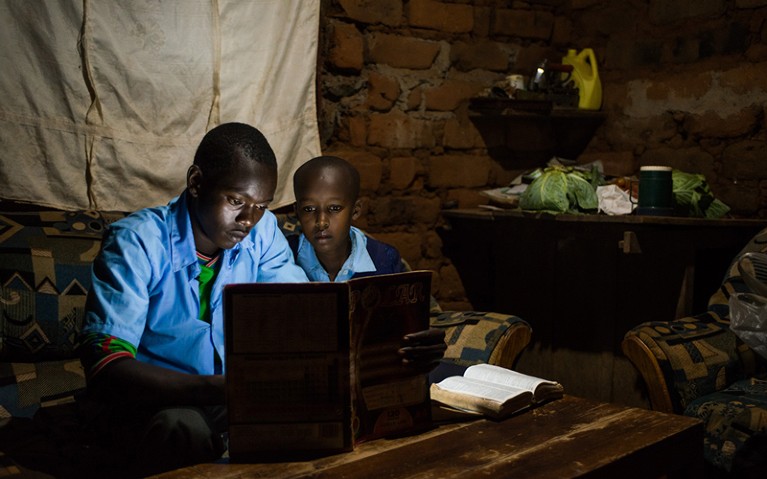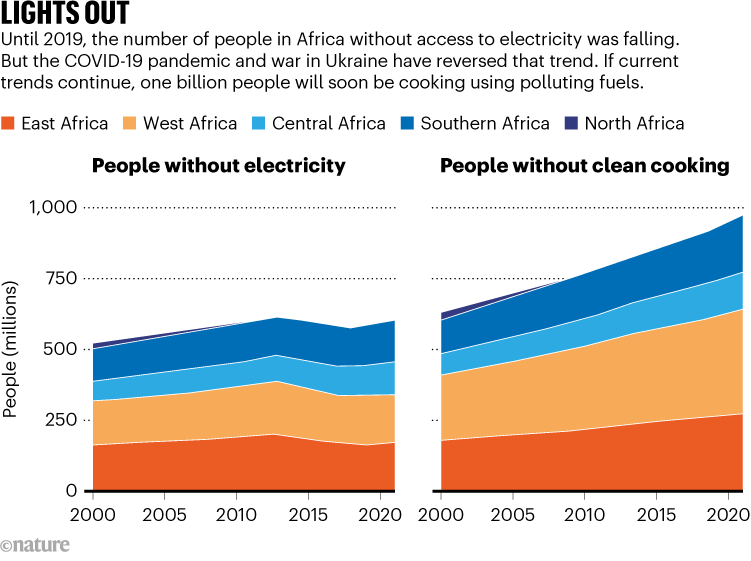
Solar-powered LED lights are helping young people in Africa to continue their studies after sunset, when mains-powered electricity isn’t available.Credit: Waldo Swiegers/Bloomberg/Getty
There’s one data point in the World Bank’s latest Africa’s Pulse report, published last month, that is impossible to ignore: 43% of the continent’s people still do not have electricity (see go.nature.com/3oploj). That number is staggering not only because it’s so high, but also because it represents a rise since the COVID-19 pandemic began (see ‘Lights out’). We are living in a time when tens of billions of dollars are being spent on developing artificial intelligence, searching for personalized medicine and exploring space. But back on Earth, 600 million Africans are being denied the ability to turn on a light switch. And around 900 million people in sub-Saharan Africa are still cooking by burning charcoal and firewood (G. Bensch et al. One Earth 4, 879–890; 2021).
The lingering effects of pandemic-induced lockdowns and disrupted supply chains are clearly contributing to the lack of these most fundamental services, the report says. But there’s arguably a bigger and more systemic reason: highly indebted countries are being stopped from investing their resources in research and development. And that, in turn, makes it harder for them to attract private investment.

Source: International Energy Agency
A report published last month by the African Development Bank shows that companies involved in mining Africa’s cobalt, lithium and nickel for use in electric-vehicle batteries will make around US$11 billion in 2025 (see go.nature.com/3Iy80ob). However, those that manufacture and assemble these batteries — most, if not all, of whom are outside Africa — will earn more than $1 trillion. The report therefore recommends that African countries establish centres of research excellence to help them participate in this higher-value manufacturing. This is an excellent idea, and it should be supported — but it simply isn’t an option for governments that are struggling to keep up with day-to-day spending.
By the end of last year, 22 African countries were in or at risk of debt distress. Their leading creditors, such as the International Monetary Fund (IMF) and governments, notably China, insist that debt repayments be prioritized, so they will need to spend most of what they earn through taxes on paying off debts. But the dysfunctional nature of today’s geopolitics means that there’s little coordination between these creditors. The IMF typically requires indebted nations to increase taxes on goods and services and decrease public spending. China’s demands are rarely made public. The IMF argues that its loan conditions safeguard spending on education, health and social protection. But a report last month from the international aid group Oxfam says that countries find it impossible to both pay off debts and protect essential public spending (see go.nature.com/43alco).
The United States can help the IMF to rethink how it lends
All of this leaves highly indebted countries with little to spend on investments, including support for their research programmes. And that means that African countries will find it hard, if not impossible, to build long-term research and development capacity in areas such as renewable energy.
Over the past several months, Africa’s leaders have held high-level meetings, organized by the United Nations, the African Union and individual governments, to discuss the need to boost investments in science and technology. The latest gathering, Africa Week, is taking place this week at the University of Pretoria in South Africa, in partnership with the country’s government and National Research Foundation. It will focus discussions on open science and equitable international research partnerships. The ambition of more equitable partnerships must also include conversations about meaningful reductions in the continent’s debts.
In the past, Africa’s research policymakers have made the case for ‘debt-for-science swaps’ — in which creditors agree to waive some debt for countries that spend more on research and development. This is not a new principle. The idea of reducing debt in exchange for a longer term investment is already being applied by the IMF and other creditors to help tackle environmental issues. Countries have been offered debt forgiveness in exchange for action on climate change or conservation goals, for example. Africa’s creditors should consider reviving this principle for research, too.
It’s a scandal that 600 million people in Africa lack access to something as fundamental as electricity — and that this number is not declining. Without debt-for-science swaps and other creative solutions, too many of Africa’s countries are at risk of being trapped in a doom loop of debt and austerity that hurts the poorest and most vulnerable populations.

 The United States can help the IMF to rethink how it lends
The United States can help the IMF to rethink how it lends
 Debt-for-climate swaps for small islands
Debt-for-climate swaps for small islands




